For historical information only, do not use for navigation or aviation purposes!
| Coordinates | N520209 E0134450 (WGS84) Google Maps |
| Elevation | 243 ft |
| Former East Germany (GDR) | District of Potsdam, District of Cottbus |
| Federal state | Brandenburg |
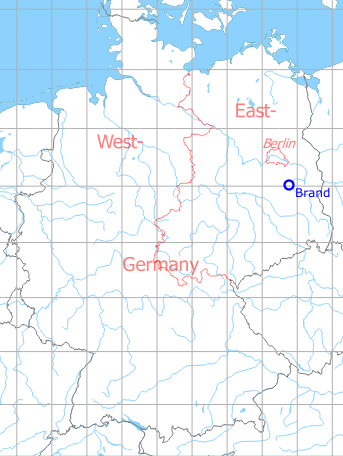
Germany during the Cold War Map
The history of the Cold War airfields: Brand
Contents
During World War II
Use
Luftwaffe airfield.
Situation
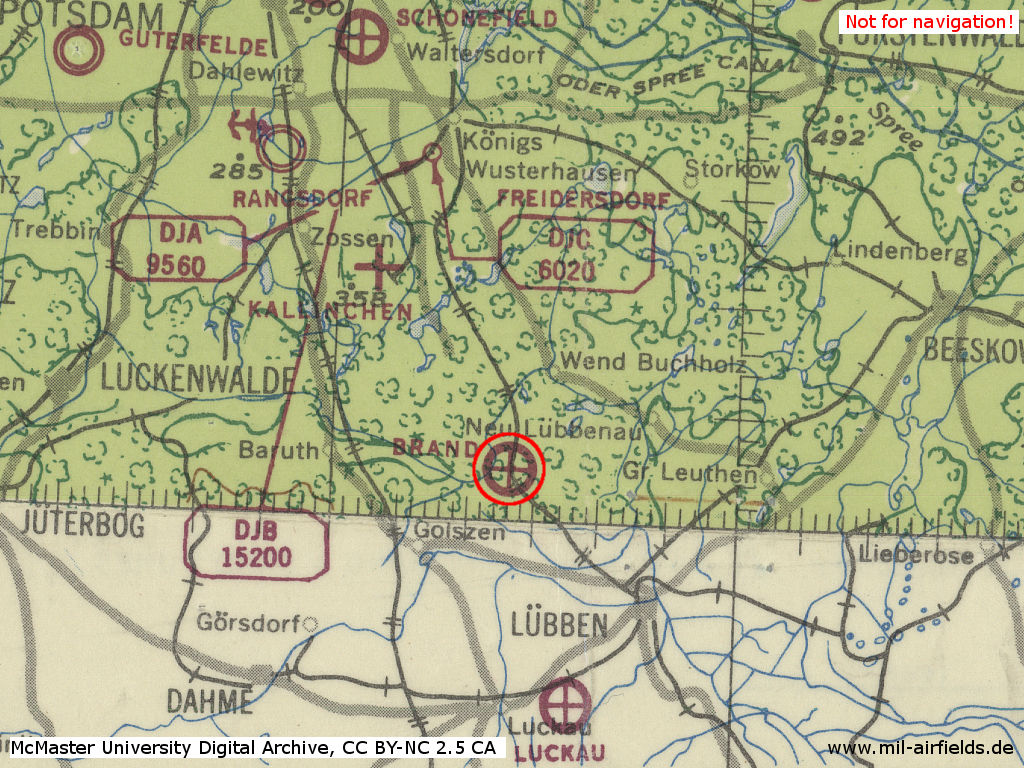
Brand on a US map from 1943
Source: McMaster University Library Digital Archive, Lizenz: Creative Commons Attribution-NonCommercial 2.5 CC BY-NC 2.5 CA /MULDA/
Overview
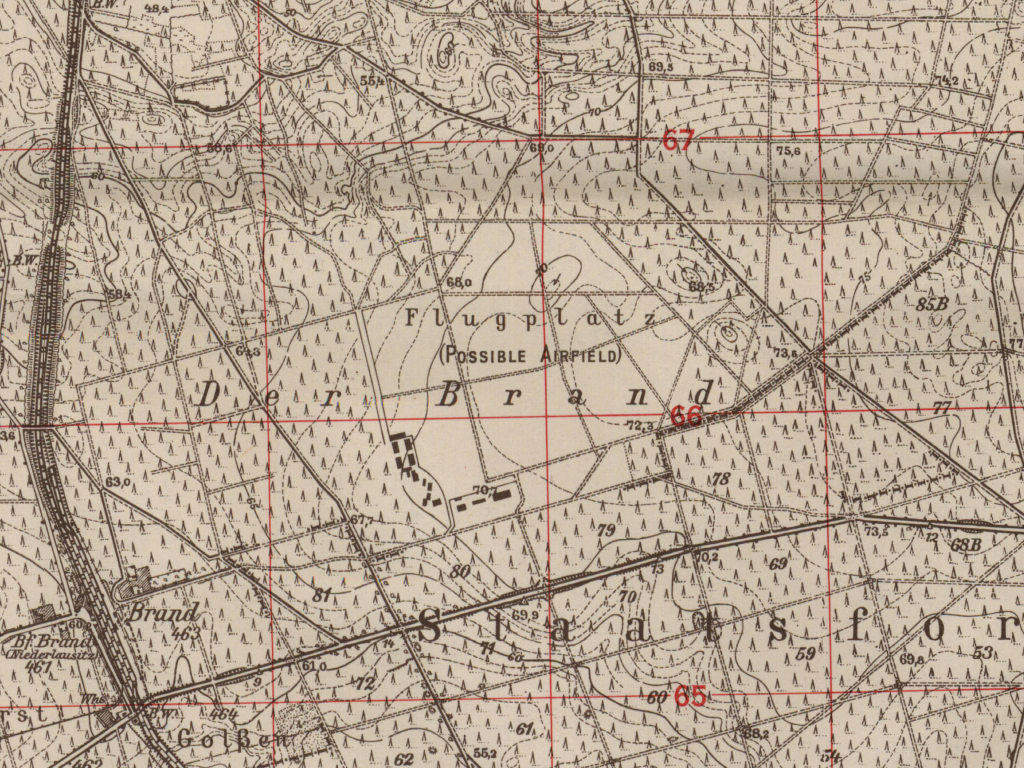
Brand Briesen airfield on a US map from 1952
Source: AMS M841 GSGS 4414, Courtesy Harold B. Lee Library, Brigham Young University /BYU/
During the Cold War
Use
Soviet airbase.
In the 1950s
General
In January 1951, work began on expanding the former Luftwaffe airbase for the Soviet armed forces. At the end of December 1951 a bomber regiment with Il-28 aircraft is stationed at the field. From January 1953 a second regiment, also equipped with Il-28, is on the aerodrome for a short period of time. At the end of June 1953 both Il-28 regiments are withdrawn, presumably to the Soviet Union. From August 1953, Brand becomes the base for a fighter regiment with MiG-15, which leaves the airfield again in May 1954. At the end of Mail 1954 another bomber regiment with Il-28 is based in Brand.
History
- Status of the construction work in February 1951
1. The Briesen (N 53/A 19) airfield was observed on 9 and 15 February 1951. The field begins about 1 km east of the Brand (N 53/A 19) railroad station and is bounded on the south by the road leading from Brand railroad station to Krausnich (correct: Krausnick) (N 53/A 19). No borders on the north and east were seen because woods were being cleared there. The landing field was about 3,000 x 3,500 meters. - Comment (CIA): The construction at the Briesen airfield was previously reported by ... Work started in January 1951. No data on the scheduled size of the landing field or other details have been received.
- 2. The Bauunion Ost Firm and Fischer Firm, Herzberg, had the contract for the work at the field. Laborers said that 460 employees were working in one shift from 7:30 a.m. to 5 p.m. More workers were allegedly to be drafted because three shifts were planned.
- Comment (CIA): ... reported that 1.200 laborers were working at the field.
- 3. A standard-gauge railroad siding was being constructed beside a narrow-gauge field railroad track beginning at the Brand railroad station and parallel to the Brand-Krausnick road. A large multi-story building under construction about 3 km east of the Brand railroad station was completed up to ist second floor. Construction on a concrete runway has not been started. Supply shipments of building material for the field arrived to the Brand railroad station where large quantities of cement and lime and two concrete mixers have already been stored. Several temporary buildings were erected near the permanent building. The exact target date for the completion of the work could not be ascertained, but laborers estimated it to be about July 1951.
- 4. Two train schedules, dated 9 and 21 February 1951 respectively, and issued by the Cottbus railroad district, were obtained. The timetables contained information on special trains for construction laborers to and from the Briesen airfield. The number of trains of the first schedule did not meet the necessary requirement so that it would have to be increased soon. (Source: CIA)
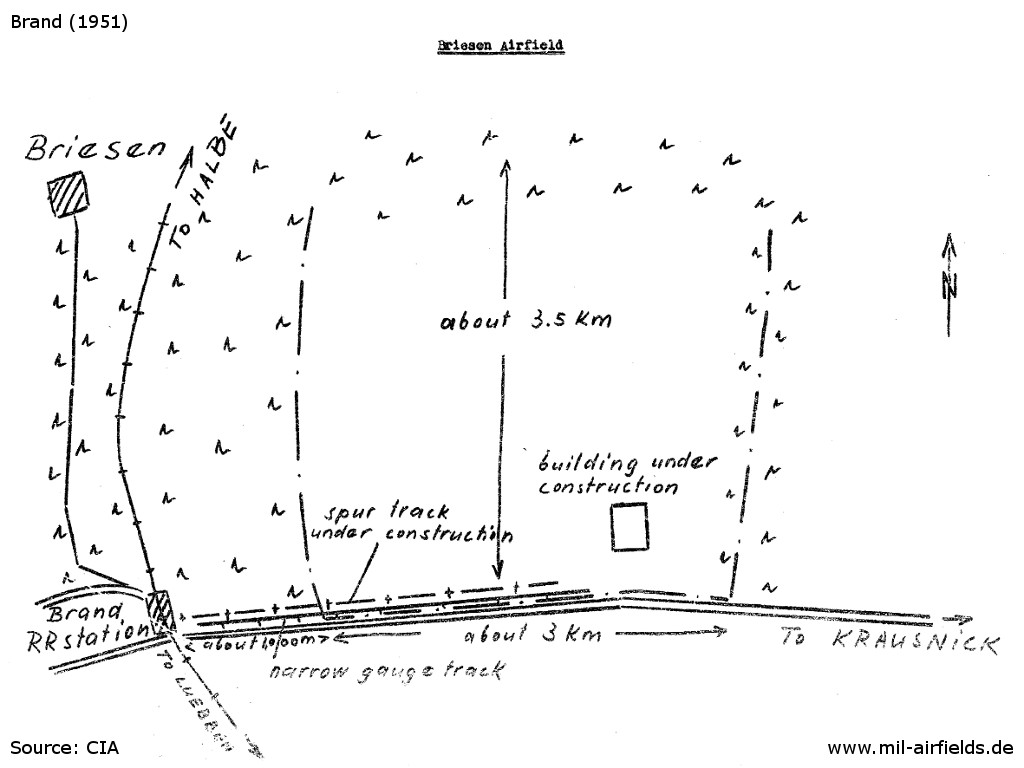 Sketch of the airfield at the beginning of the construction worksSource: CIA
Sketch of the airfield at the beginning of the construction worksSource: CIA- Status of the construction work in May / June 1951
1. On 29 May 1951, a conference, concerning construction work at Briesen airfield, was held in Brand with representatives of the SCC in Berlin-Karlshorst, the Landesregierung of Brandenburg, the Cottbus regional railroad headquarters, and the Bauunion construction firm. In this conference the target date for the completion of the work was advanced by six weeks and set for 10 August 1951. - Comment (CIA): The target date reported probably refers only to the completion of the concrete runway which is to be 3,000 meters long. It is not possible that the entire airfield will be completed by 30 August.
- 2. On 3 June, ... the target for completion of the work at Briesen airfield was advanced from 1 October to 15 August 1951. Work was being done by 1,500 laborers working in three shifts. Two hundred carloads of broken stones, cement, and gravel arrived daily. On request of the Bauunion firm, a locomotive was mad available after 4 June 1951 at the Brand railroad station for shipping of construction material to the field.
- 3. Between 3 and 19 June, a Soviet tractor brigade of 80 men was still employed at the field. The brigade was equipped with three heavy tractors, five trucks, and several tank trucks. ... an estimated 2,000 men were probably employed. ... a representative of the Bauunion firm asked for an additional hundred workers because the target date for the completion of the runway was allegedly advanced to late-August 1951.
- 4. Moral among the German laborers was low because of the high norms required. On 15 June, Rudi Jahn, Minister President of Land Brandenburg, held a rally in front of the construction bureau. The personnel of the airfield and pupils of eight elementary schools took part in this rally.
- 5. Work was being done in three shifts. The construction sites, particularly the runway, were illuminated by strong lamps after nightfall. The Soviet brigade graded the area of the runway. Heavy rollers fitted with spikes, bulldozers, and ordinary rollers, towed by tractors, were used. On 16 June, 300 meters of the runway were concreted and on 19 June, a strip of about 350 meters was completed. A new storage shed was erected southeast of the flight control building. A strip of woods about 150 to 200 meters was cleared on both sides of the runway for security reasons. A tractor was plowing the cleared strip. The turning aprons at the end of the runway were only graded but not provided with a hard surface.
- 6. Ten carloads of basaltic ballast which arrived by rail were unloaded at the storage shed for cement. The individual rocks were about 4 cm large. It could not be determined for what purpose the ballast was used. A strip about 100 x 200 meters, apparently for the construction of a taxiway, was cleared about 600 meteres east of the end of the spur track, along the Brand-Krausnick road toward the runway. No lighting facilities were seen along the runway or on the edge of the field.
- 7. Of the scheduled 13 brick buildings, six were under construction. Two buildings were covered with roofing paper. Each building, 15 x 60 meters, had 16 windows. An educational building was being constructed in forest subarea (Jagen) No. 60, opposite the brick buildings. According to the land-registry office, approach lanes were planned to be cut in the eastern and western extensions of the runway. There approach lanes were to be 500 meteres square from the edge of the field. The question whether the railroad line was to be moved 5 km farther westward was raised but bot decided upon.
- 8. The airfield was still guarded by ten civilian guards wearing red armbands with the inscription "Factory Police". It was learned from talks with laborers that the former construction superintendent Fl... (first name unknown), was no longer at the field and that he had allegedly fled to the west.
- 9. On 23 June, a strip of about 800 meters of the E-W runway, which was about 60 meteres wide, was under construction at the field. Light poles were erected on the southern edge of the runway. The construction laborers used three power shovels and three concrete mixers. A building about 6 x 20 x 50 meters, was under construction on the southern edge of the field. ** The airfield was guared by civilians. ...
- ** Comment (CIA): A hangar is possibly under construction. (Source: CIA)
- 26 December 1951
The bomber regiment from Oranienburg airfield, equipped with Il-28, is transferred to Brand. (Source: CIA) - 08 January 1953
The bomber regiment from Finsterwalde Air Base, equipped with Il-28, moves to Brand. (Source: CIA) - Late Juni 1953
Both Il-28 regiments leave the airfield. (Source: CIA) - August 1953
Relocation of a Fighter Wing from Falkenberg/Alt Lönnewitz Air Base to Brand/Briesen. (Source: BND/Bundesarchiv B 206/3033) - May 1954
Relocation of the Fighter Wing (PFN 62 334) to Altenburg Airfield. (Source: CIA) - 22 May 1954
The first Il-28 of a new regiment arrives at the airfield, (Source: BND/Bundesarchiv B 206/3033) - 25 May 1954
Meanwhile, the number of Il-28 at the Brand/Briesen airfield has increased to 31. (Source: BND/Bundesarchiv B 206/3033) - 03 October 1954
At the airfield 27 Il-28 take off at a distance of 10 seconds from aircraft to aircraft. The formation flies in three squadron wedges of 9 aircraft each, with a distance of about one aircraft length and a lateral gap of about one aircraft width. This unit is accompanied by 25 MiG-15. (Source: BND/Bundesarchiv B 206/3033)
Soviet Il-28
In the 1960s
Situation
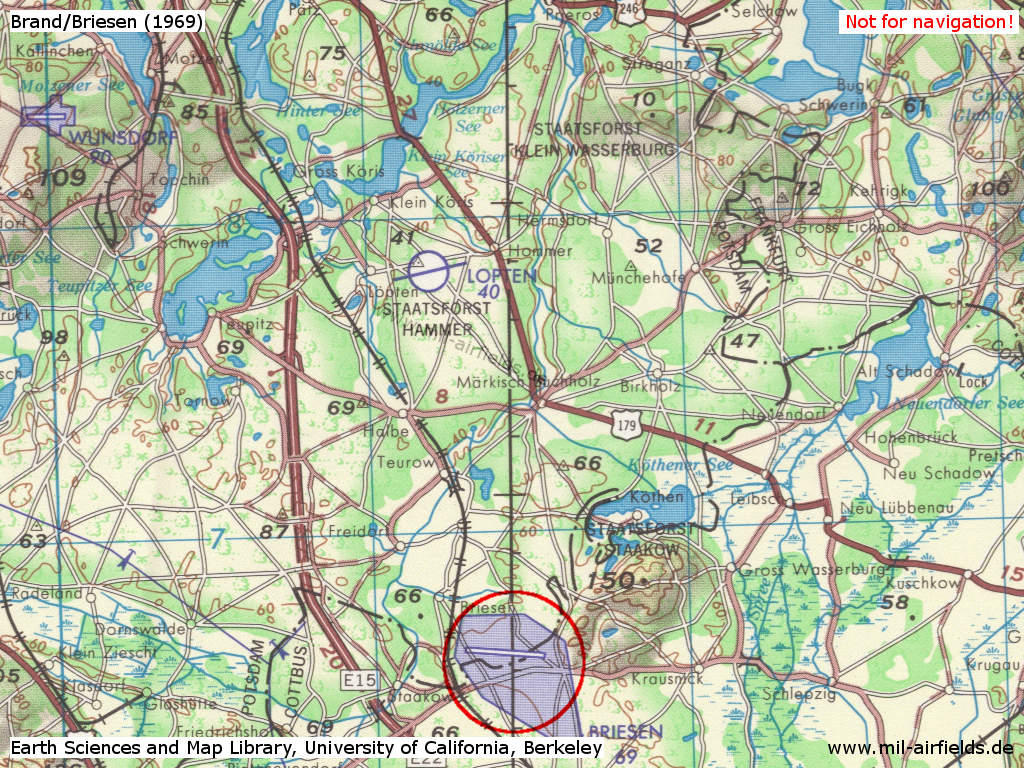
Brand Air Base on a US map from 1969
Source: Quelle: Earth Sciences and Map Library, University of California, Berkeley
Overview
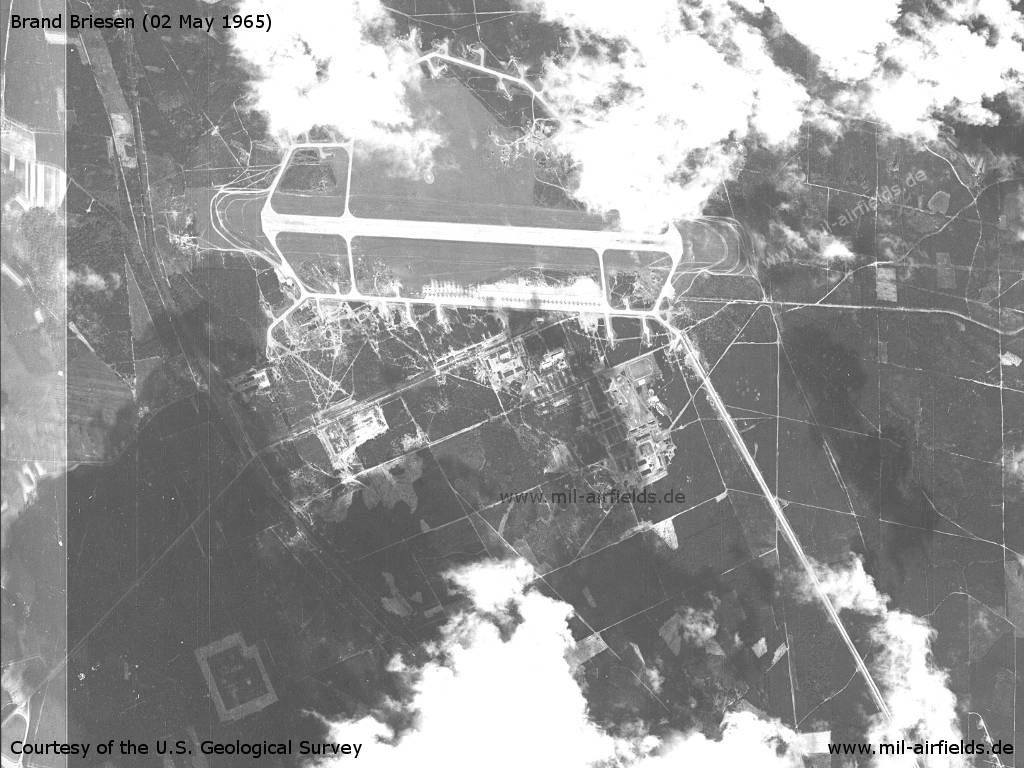
US satellite image of the Soviet Brand Briesen airfield from 02 May 1965
Source: U.S. Geological Survey
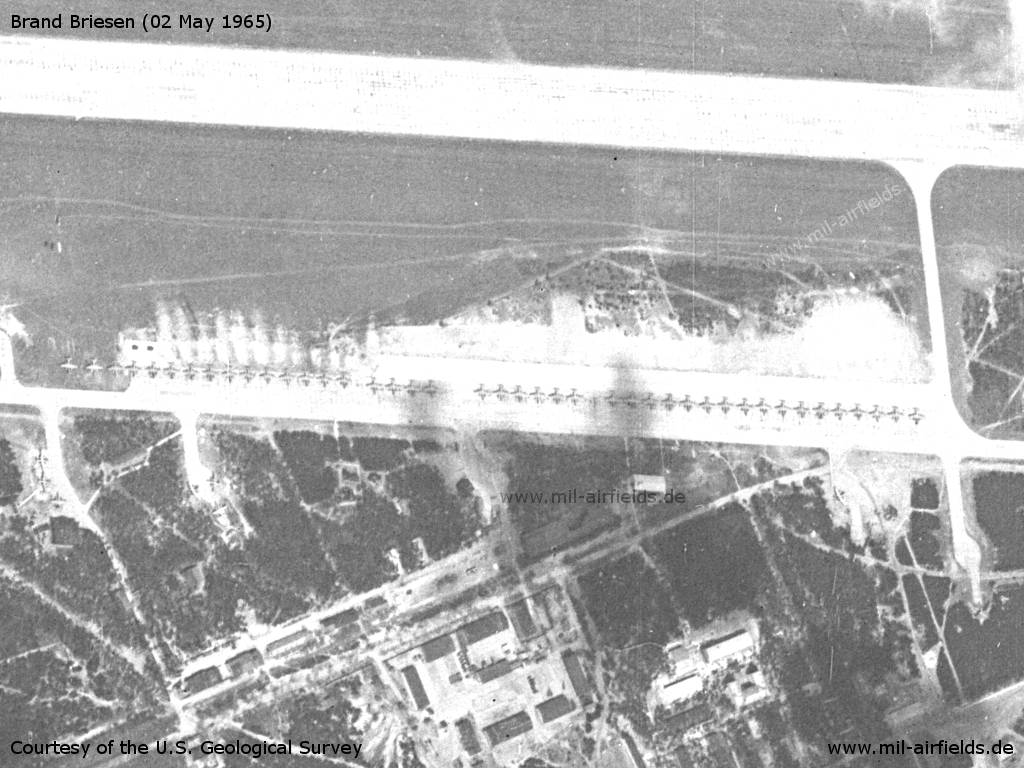
Enlargement: There are 42 Il-28 on the flightline and 8 other aircraft of this type in the boxes around it.
Source: U.S. Geological Survey
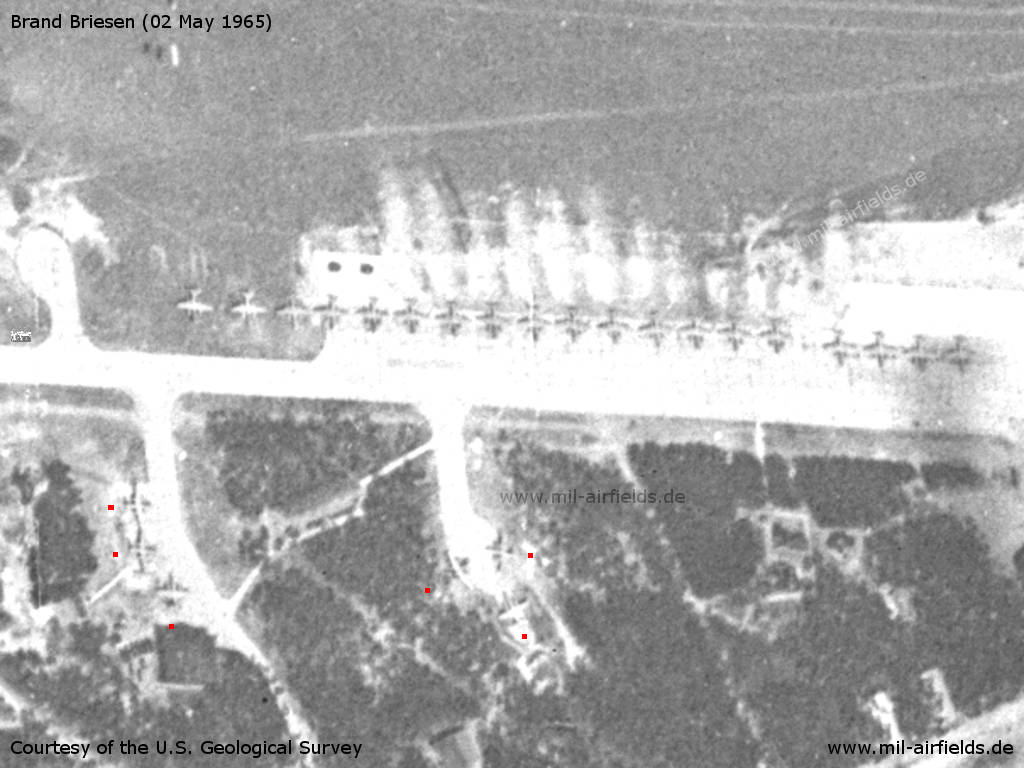
Flightline, western part
Source: U.S. Geological Survey
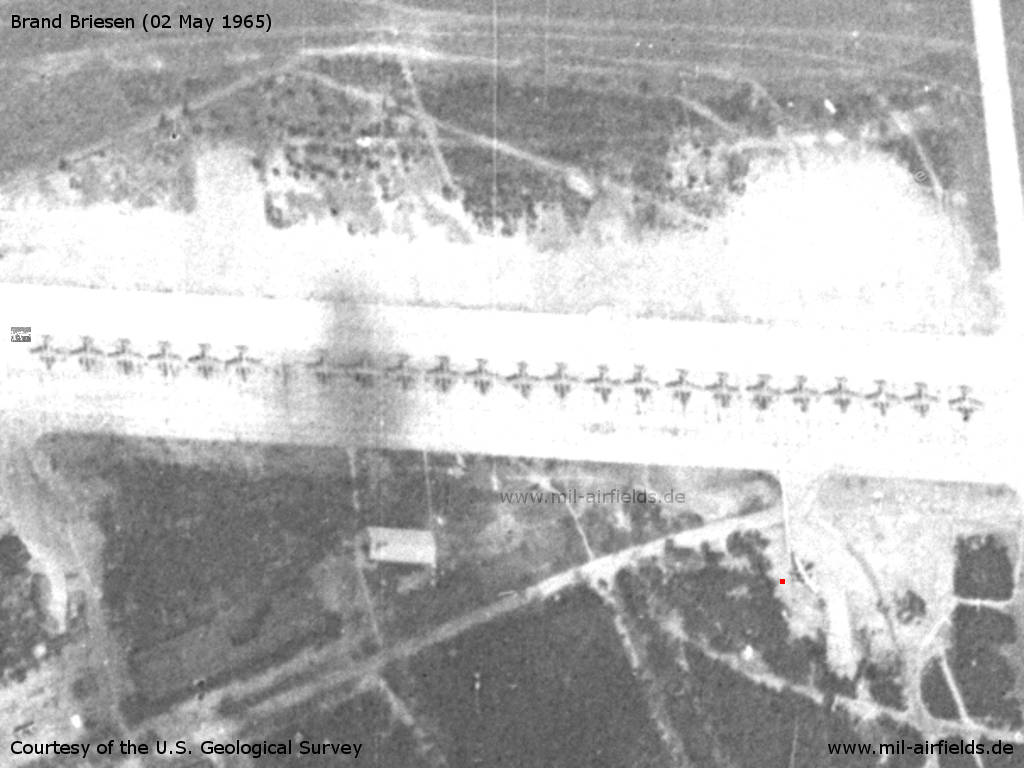
Flightline, eastern part
Source: U.S. Geological Survey
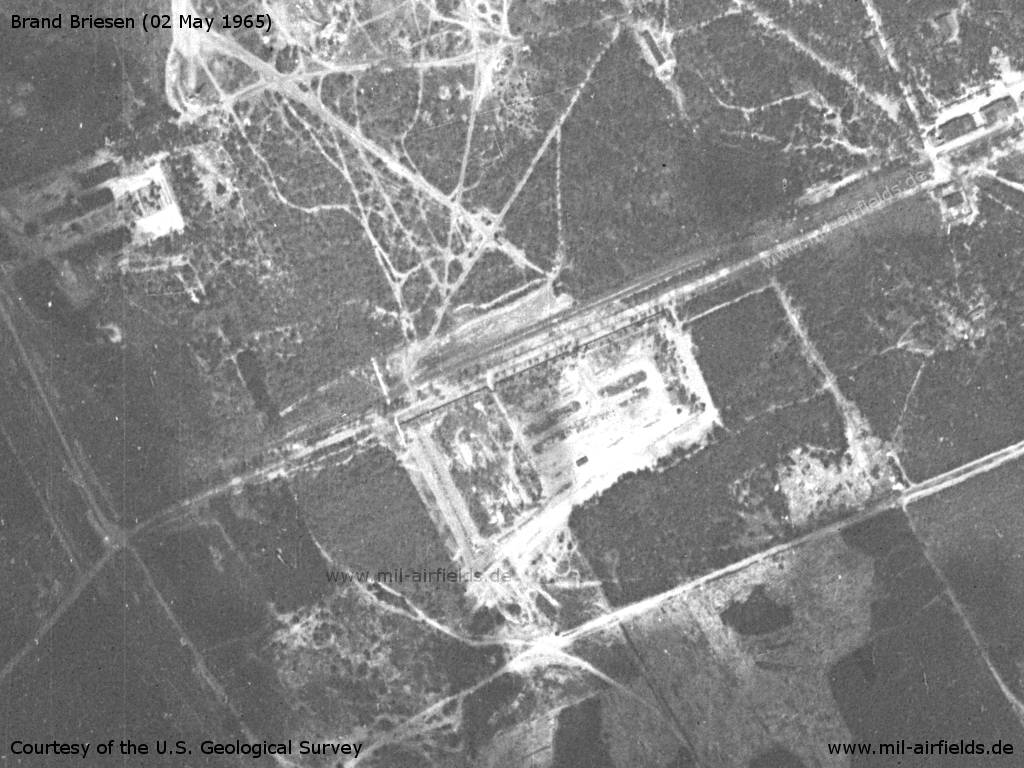
Installations
Source: U.S. Geological Survey
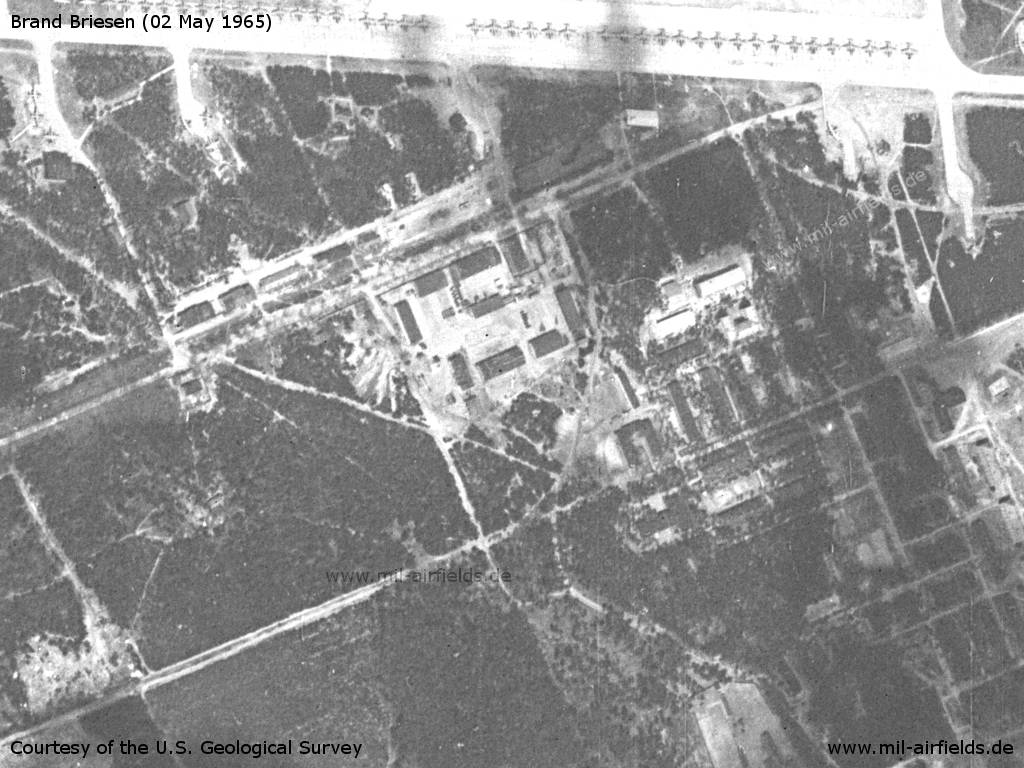
Buildings
Source: U.S. Geological Survey
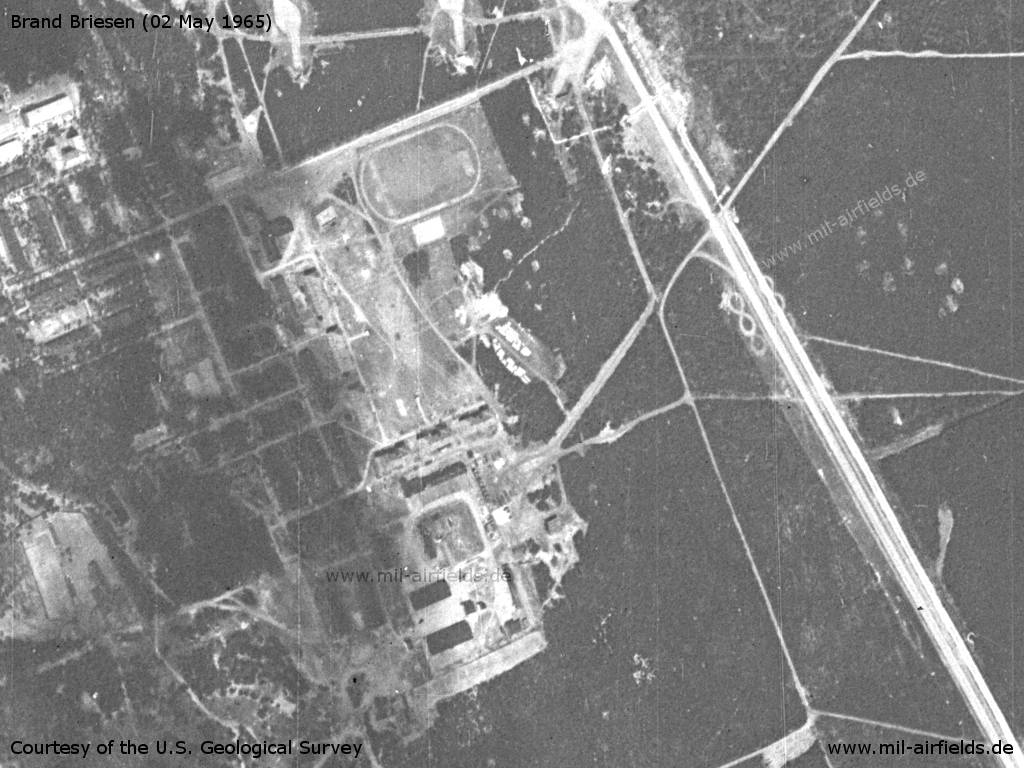
On the eastern side is the auxiliary runway, which runs approximately from northwest to southeast.
Source: U.S. Geological Survey
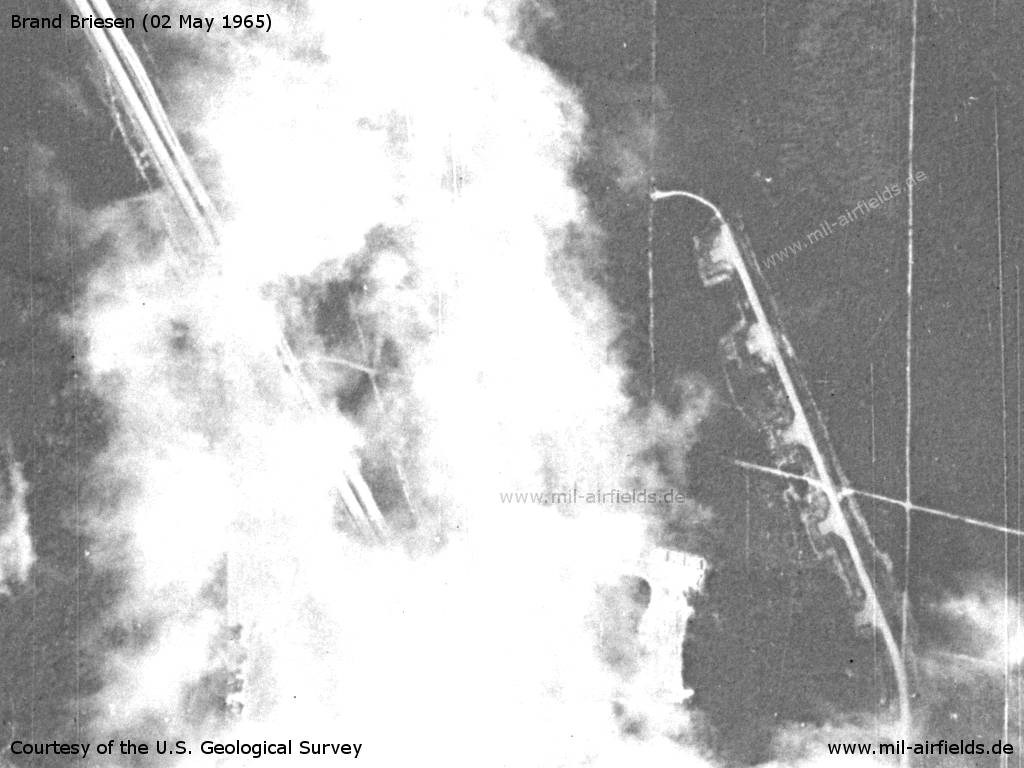
Parking area at the end of the auxiliary runway in the southeast
Source: U.S. Geological Survey
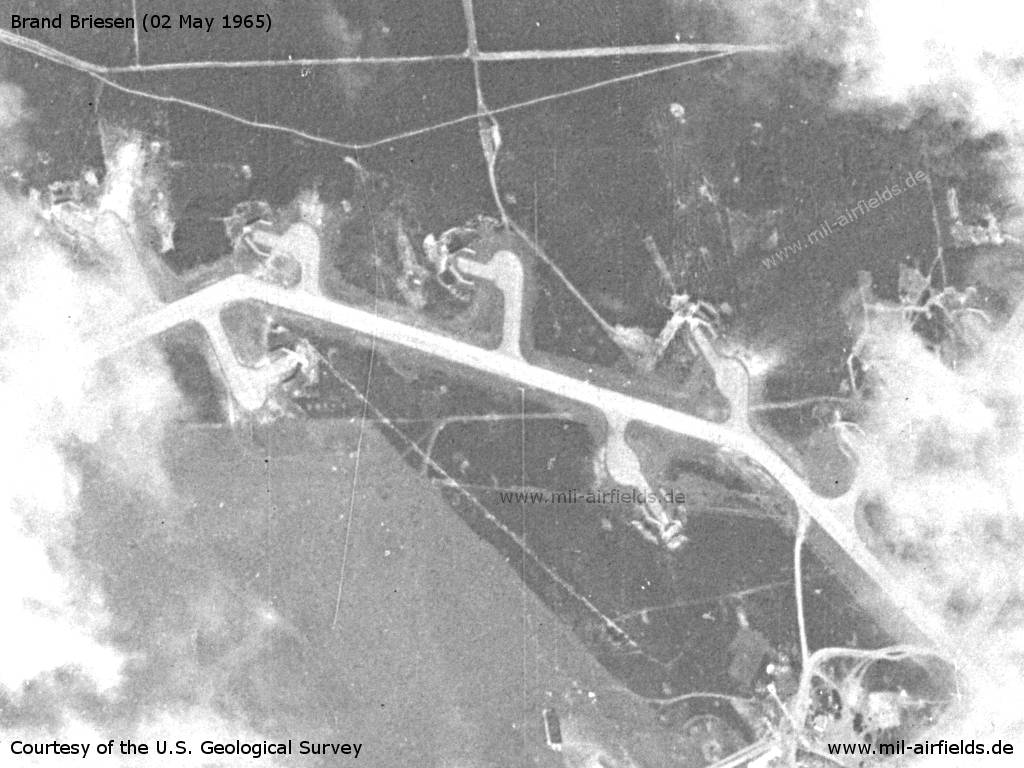
Revetments in the north
Source: U.S. Geological Survey
In the 1970s
Situation
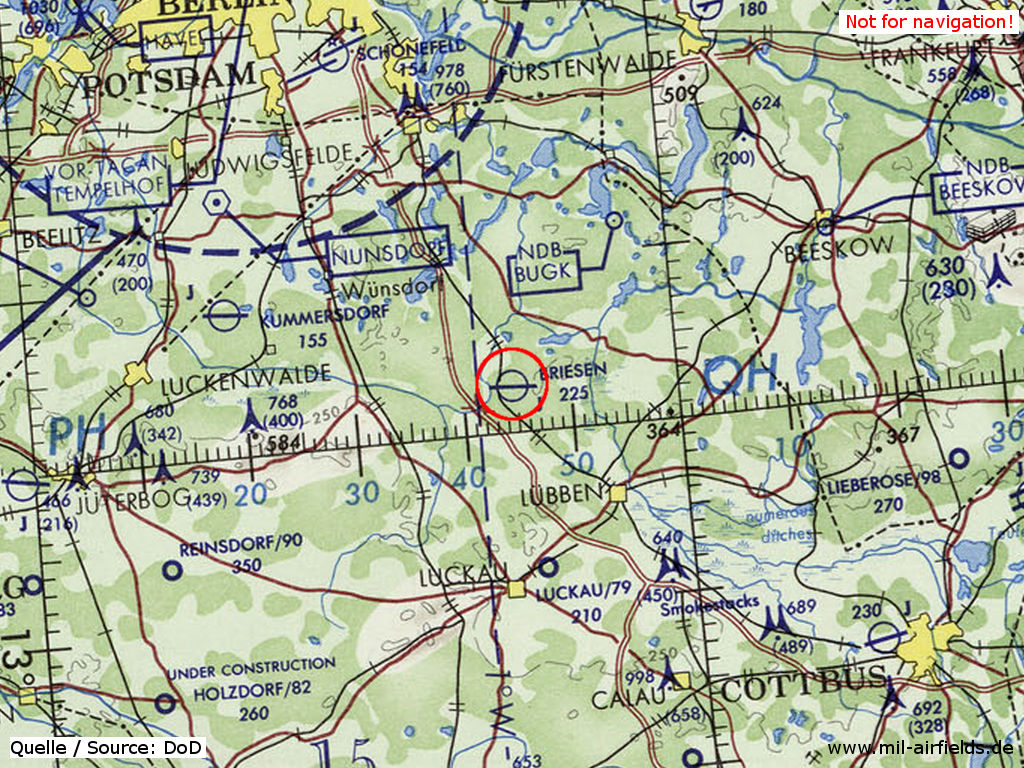
Brand Air Base on a map of the US Department of Defense from 1972
Source: ONC E-2 (1972), Perry-Castañeda Library Map Collection, University of Texas at Austin /PCL MC/
Overview
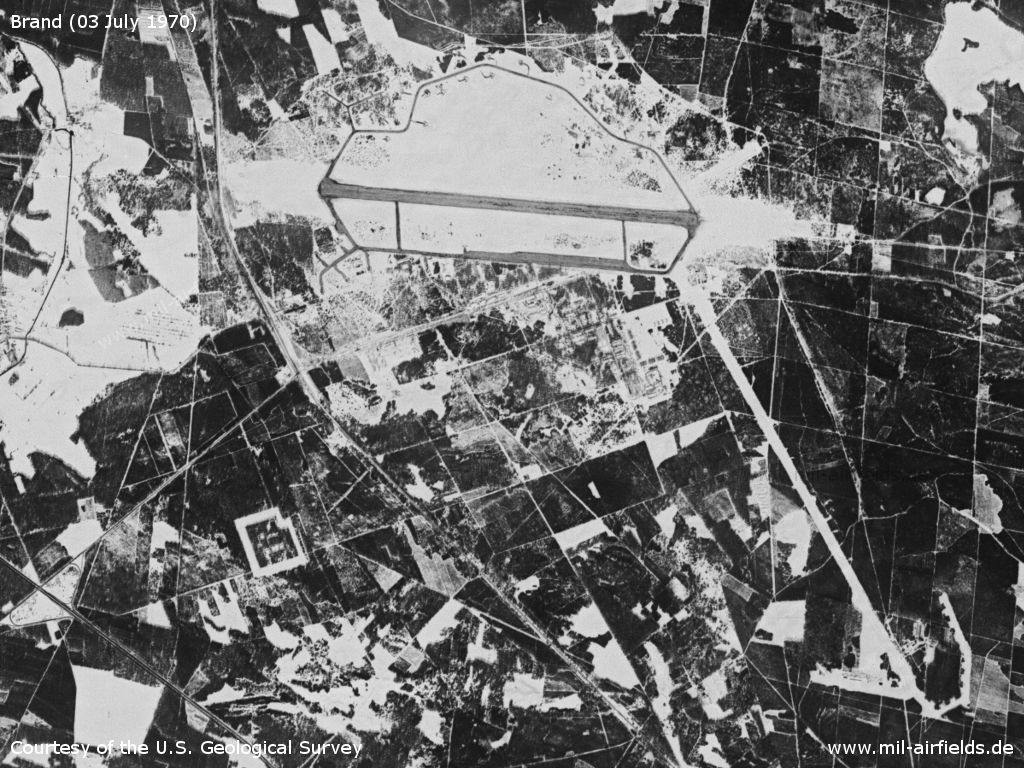
Brand Air Base on a US satellite image from 10 March 1970 - The auxiliary runway into direction south-east is not cleared
Source: U.S. Geological Survey
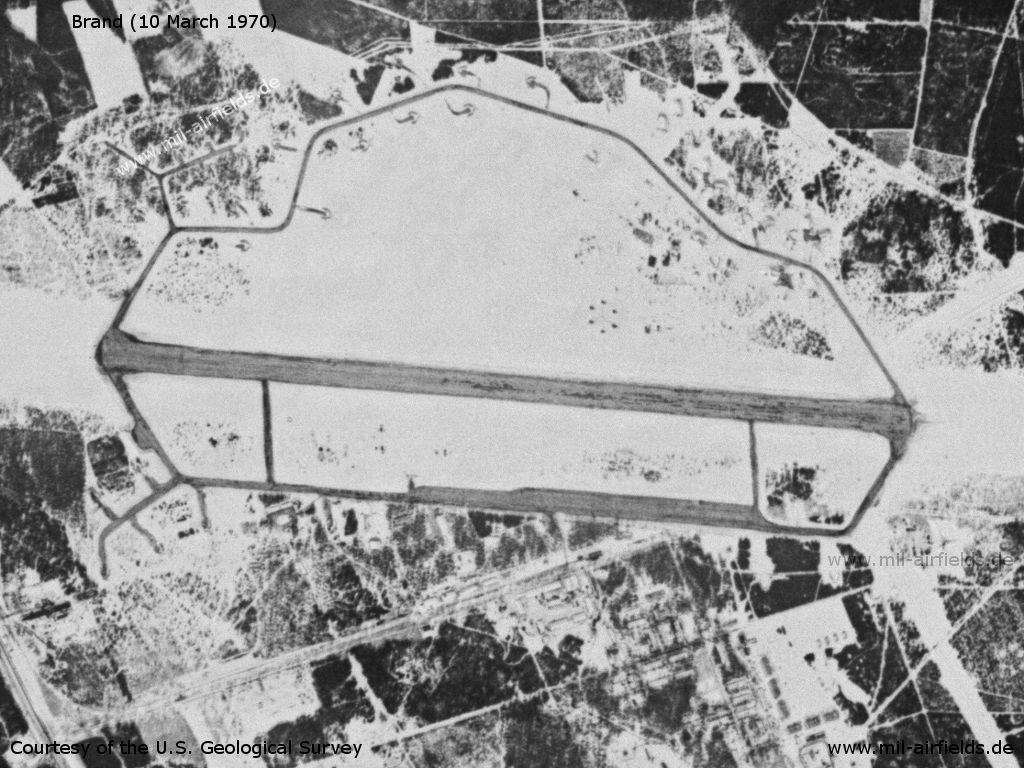
Enlargement: At this time there was only one runway - Remarkable are the six points north of the runway. An anti-aircraft site?
Source: U.S. Geological Survey
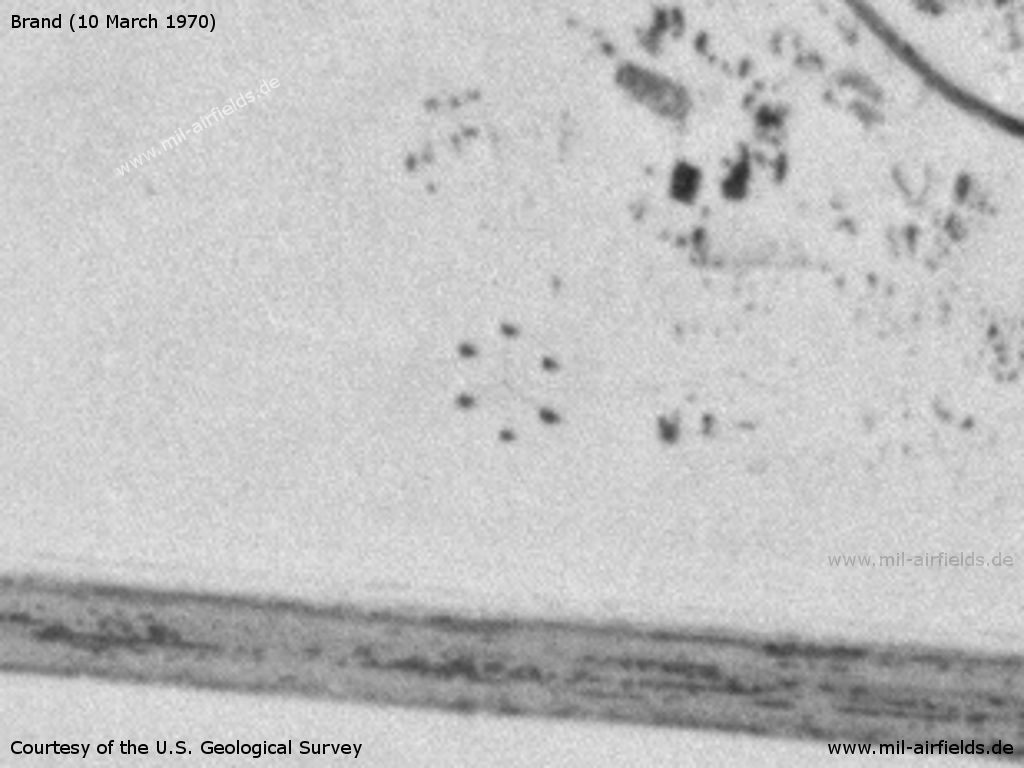
The six points enlarged - Some points seem to have a connection to the center
Source: U.S. Geological Survey
In the 1980s and early 1990s
Overview
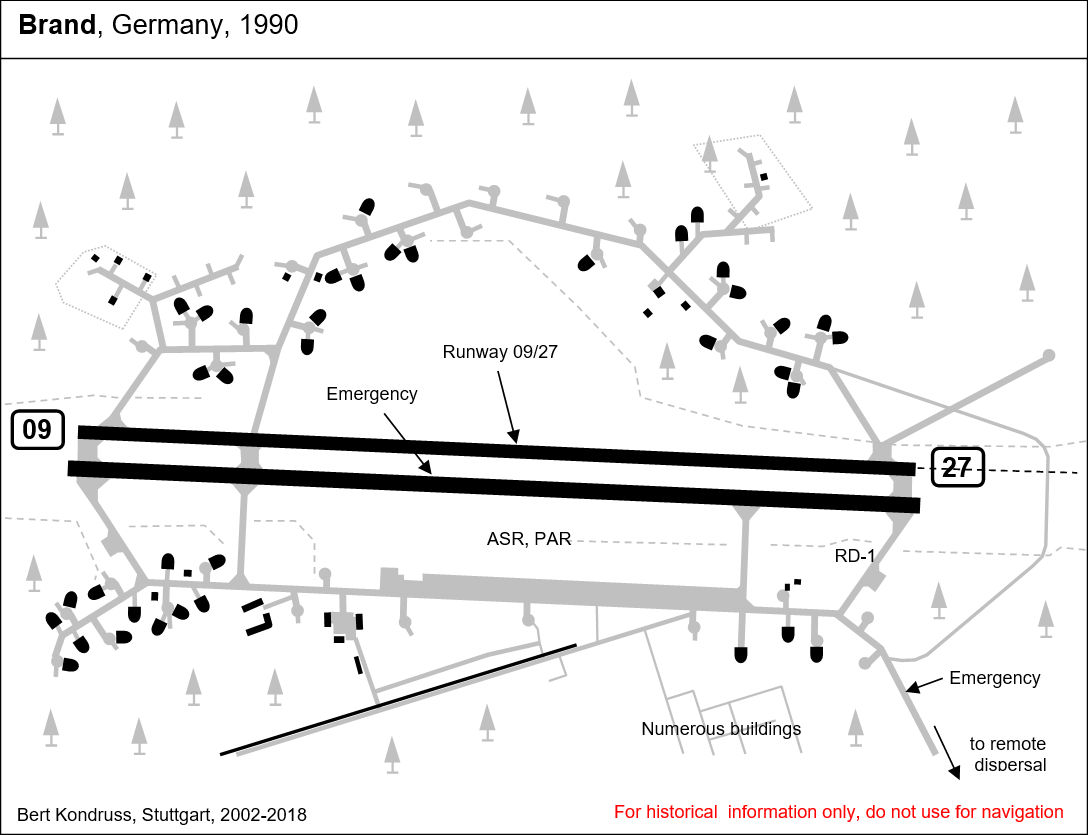
Runways
- 09R/27L: 2500m Concrete Main runway
- 09R/27R: 2500m Concrete Emergency
- 16/32: 2000m Concrete Emergency
Radio beacons
- LOM 27: 360 "DW"
- LMM 27: 735 "D"
- LOM 09: 360 "ZP"
- LMM 09: 735 "Z"
Radio communication
The russian radio call sign for the airfield was ZWEROBOJ ("Hypericum", original notation in Cyrillic: ЗВЕРОБОЙ)
Weather station
Auf einer Karte mit Wetterstationen, die Anfang der 1990er Jahre in der Flugleitung am Flugplatz Sperenberg hing, war für Brand der Name PROSELOK eingetragen (= Tarnname der Wetterstation Brand?)
Standard training routes
"Flüge der LSK/LV der NVA und der LSK der GSSD im Rahmen der Gefechtsausbildung sind entsprechend der Grafik der Flugtage / -nächte auf der Grundlage der "Hauptflugregeln zum Fliegen im Luftraum der Deutschen Demokratischen Republik" auf Standardflugstrecken in den dazu festgelegten Flughöhen durchzuführen. ..." (Quelle: "Verzeichnis der Standardflugstrecken der LSK/LV der NVA und der LSK der GSSD"
Stand 1989:
325 Brand, Baruth, Schießpltz Heidehof, Markendorf, Kahnsdorf, Brand
Höhe: 600 m
326 Brand, Finsterwalde, Glaubitz, Schießplatz Belgern, Mühlberg, Bahnhof Haida, Brand
Höhe: zum Schießplatz 300, 500 m
Rückflug 1200, 3650 m
326a Brand, Schweinitz, Schildau, Schießplatz Belgern, Wülknitz, Haida, Brand
Höhe: 300 - 1850 m
328 Brand, Freiberg, Piesteritz, Brand
Höhe: 6700 m
Höheneinnahme: über dem Flugplatz
Höhenaufgabe: über dem Flugplatz
329 Brand, Raguhn, Lübbenau, Brand
Höhe: 11900 - 18000 m
Höheneinnahme: 6700 m über dem Flugplatz, 11900 m Traverse Wittenberg
Höhenaufgabe: Lübbenau
330 Brand, Dahme, Jessen, Fichtenwalde, Breddin, Schießplatz Wittstock, Altes Lager, Brand
Höhe: zum Schießplatz 300, 600 m
Rückflug 5500 m
330a (Bei Durchführung von Flügen am Flugplatz Holzdorf)
Brand, Wahlsdorf (5 km südlich Petkus), Blönsdorf, Fichtenwalde, Breddin, Schießplatz Wittstock, Altes Lager Brand
Höhe: bis Blönsdorf 1200 m, weiter 300 - 600 m
zurück 5500 m
331 Brand, Jessen, Havelberg, Schießplatz Wittstock, Altes Lager, Brand
Höhe: zum Schießplatz 4900 m, Rückflug 5500 m
331a Brand, Altes Lager, Havelberg, Schießplatz Wittstock, Altes Lager, Brand
Höhe: 5500 m, Gleitflug nach Havelberg bis Traverse Kyritz nicht unter 3650 m, weiter nach Aufgabe
332 Brand, Altes Lager, Havelberg, Parchim, Franzburg, Pasewalk, Templin, Schießplatz Wittstock, Altes Lager, Brand
Höhe: bis Parchim 4900 m, bis Franzburg 1850 m, bis Pasewalk 1200 m
weiter bis zum Schießplatz 300, 600 m,
zurück 5500 m (Steigflug über dem Schießplatz)
Stand 1989:
325 Brand, Baruth, Schießpltz Heidehof, Markendorf, Kahnsdorf, Brand
Höhe: 600 m
326 Brand, Finsterwalde, Glaubitz, Schießplatz Belgern, Mühlberg, Bahnhof Haida, Brand
Höhe: zum Schießplatz 300, 500 m
Rückflug 1200, 3650 m
326a Brand, Schweinitz, Schildau, Schießplatz Belgern, Wülknitz, Haida, Brand
Höhe: 300 - 1850 m
328 Brand, Freiberg, Piesteritz, Brand
Höhe: 6700 m
Höheneinnahme: über dem Flugplatz
Höhenaufgabe: über dem Flugplatz
329 Brand, Raguhn, Lübbenau, Brand
Höhe: 11900 - 18000 m
Höheneinnahme: 6700 m über dem Flugplatz, 11900 m Traverse Wittenberg
Höhenaufgabe: Lübbenau
330 Brand, Dahme, Jessen, Fichtenwalde, Breddin, Schießplatz Wittstock, Altes Lager, Brand
Höhe: zum Schießplatz 300, 600 m
Rückflug 5500 m
330a (Bei Durchführung von Flügen am Flugplatz Holzdorf)
Brand, Wahlsdorf (5 km südlich Petkus), Blönsdorf, Fichtenwalde, Breddin, Schießplatz Wittstock, Altes Lager Brand
Höhe: bis Blönsdorf 1200 m, weiter 300 - 600 m
zurück 5500 m
331 Brand, Jessen, Havelberg, Schießplatz Wittstock, Altes Lager, Brand
Höhe: zum Schießplatz 4900 m, Rückflug 5500 m
331a Brand, Altes Lager, Havelberg, Schießplatz Wittstock, Altes Lager, Brand
Höhe: 5500 m, Gleitflug nach Havelberg bis Traverse Kyritz nicht unter 3650 m, weiter nach Aufgabe
332 Brand, Altes Lager, Havelberg, Parchim, Franzburg, Pasewalk, Templin, Schießplatz Wittstock, Altes Lager, Brand
Höhe: bis Parchim 4900 m, bis Franzburg 1850 m, bis Pasewalk 1200 m
weiter bis zum Schießplatz 300, 600 m,
zurück 5500 m (Steigflug über dem Schießplatz)
Real property
The airfield had an area of 620 ha.
Installations
Railway siding in the south of the airfield.
The airfield's anti-aircraft missile site was northeast of Rietzneuendorf.
The airfield's anti-aircraft missile site was northeast of Rietzneuendorf.
Images
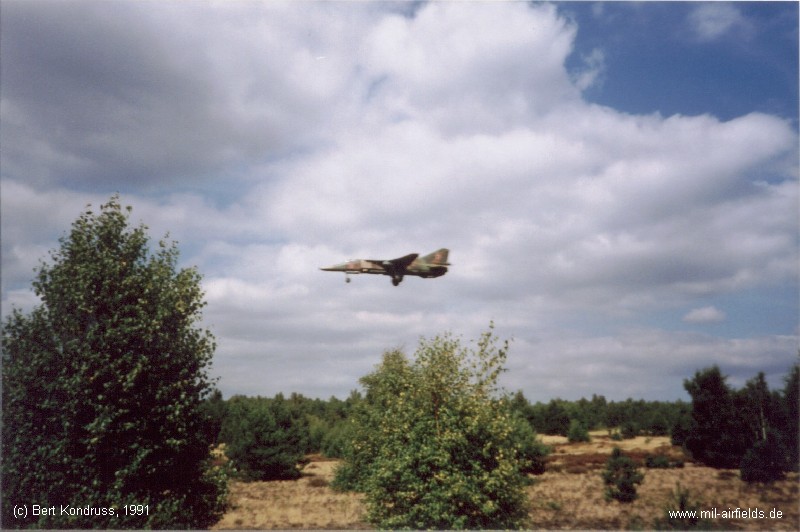
An aircraft MiG-27 approaching from the east (1991)
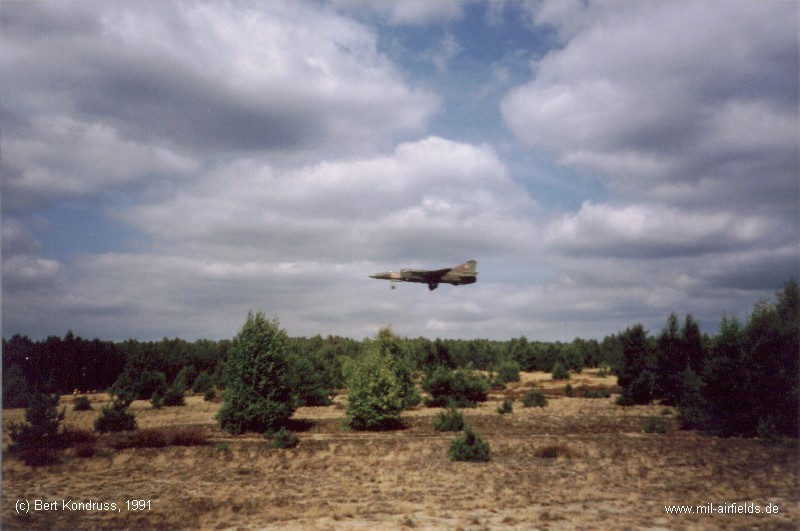
A two-seater training aircraft MiG-23UB.
In the 1990s
Use
At the end of the 1990s, the company Cargolifter built a large hangar for airships at the airport.
Today
Use
Closed. The large hangar houses the "Tropical Islands" theme park.
Airfields in the vicinity
- 350°/13km Kleinköris / Löpten: Airfield (Löpten, Klein Köris)
- 104°/16km Biebersdorf: Helipad 3022 (HSLP / HLP 3022)
- 096°/18km Krugau: Helipad 3036 (HSLP / HLP 3036)
- 173°/19km Alteno: Airfield (Luckau)
- 042°/20km Kehrigk: Helipad 3071 (HSLP / HLP 3071)
Categories
Military Airfields GermanyMilitary Airfields in former East GermanyAirfields of the Soviet Forces in GermanyContents